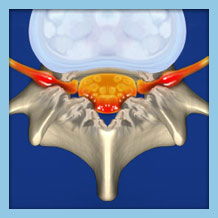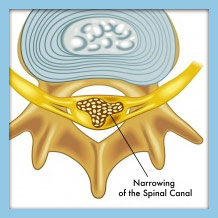

How Do I Know if I have Spinal Stenosis?
Cervical Spinal Stenosis is the narrowing of the cervical spine pathway of the spinal cord. The spinal cord needs proper room to work. It controls things such as your arm and leg movements and bladder and bowel control.
If it is squeezed too much you can get a shock like pain, tingling, arm weakness, arm and hand numbness, radiculopathy (nerve root pain or symptoms), clumsiness, loss of balance, difficulty walking and loss of bladder control.
Do you have any of these symptoms and think you may be suffering from cervical spinal stenosis? We have a quick and easy tool to help gather some information from you to help us determine what your problem is and get you on the road to recovery.
What is the Right Treatment for Me?
Cervical laminoplasty is a surgery we do at Orthopedic and Laser Spine Surgery to specifically open that compressed canal back up. We essentially de-clog your nerve pipe. This is generally indicated by three or more levels of disease. Single level canal stenosis can be treated with a decompression from the front and a fusion. This is the most common method. For single level stenosis, we prefer a decompression and then an artificial disc replacement. This preserves motion without a fusion. No fusion equals no stiffness.
Multiple level stenosis can be treated with a multiple level fusion but this would not be wise. For instance, if a patient had four levels of severe stenosis and became myelopathic they would have clumsiness, difficulty walking, and numbness or shock-like pain in any of their four extremities. You could treat this with a corpectomy and fusion but a four level fusion will leave you with a stiff neck for life! Alternatively, four artificial discs could theoretically work. Currently, they are approved for only two level disease. So a laminoplasty is your best and should be your only option.
More about Cervical Laminoplasty
The main advantage of this laminoplasty versus a fusion is motion preservation. The normal neck components are retained. The only disadvantage to a laminoplasty is it is intended to fix spinal stenosis. It generally does not correct axial (neck) pain. It only helps resolve arm and leg pain and headaches. To fix axial pain the artificial disc would be the wisest choice.
Cervical Laminoplasty Surgery
This surgery is done posteriorly. An incision is made in the back of your neck. The muscles are temporarily shifted out of the way. At each bone level, the lamina is carefully cut and then opened up. By lifting it up, the spinal cord space is enlarged. This is like opening a door to relieve the pressure.
Post-Op Recovery
The recovery is generally quick. In most cases, it can be done with an overnight stay in the hospital. Occasionally it can be done on an outpatient basis. The pain subsides significantly on the third post-operative day. The neck can move immediately after surgery which also helps prevent stiffness.
